| These highlights chronicle the year 2006. Created incrementally as
new photos were available, the year runs generally "backwards" on this
page.
The abbreviation "MTY" means "Monterey County" in the
text below. Text by Don Roberson. Photos on this page are copyrighted
by the photographers to whom they are attributed, and may not be
reproduced in any form (including other web sites) without the express
consent of the photographer. |
|
|
| It is starting out as a fine fall migration for Semipalmated Sandpipers
locally. Two adults were located in July (one is shown below following
photos of several other species) and already 3 juvenals have been found
between 29 July-1 August (all 3 found by Brian Sullivan). Two are shown
above: one near Salinas 29 July (left) was a bit fresher and brighter than
another at Asilomar State Beach 30 July-1 Aug (right). The excellent photo
(© Brian L. Sullivan, left) shows the webbed toes well [more photos
by Brian Sullivan are on
his
web site]. The Asilomar bird (right © Don Roberson) was posed
nicely next to an adult Western, allowing comparison of bill size and shape,
plus contrasting differences between adult and juvenal plumages.
Meanwhile, at the Big Sur R. mouth, up to 2 Chimney Swifts were
flying with martins, swallows, and Vaux's Swifts near the BSOL lab building
between 28 July-1 August (Oscar Johnson, Matt Brady). |
|
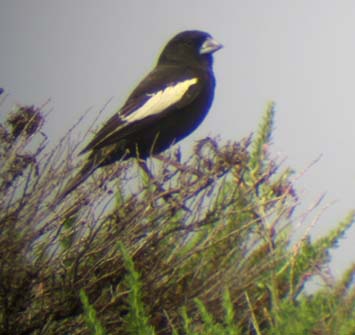
|
A major mid-summer highlight was a singing Lark Bunting in coastal
scrub at Pt. Lobos State Reserve on 24 July. Initially found by visitors
from Pasadena (names unknown), it was nicely digiscoped at mid-day (left
© Stan Dryden). Unlike other Great Plains birds that have no pattern
of coastal wandering in summer (see below), the Lark Bunting is a known
irruptive species. It has even nested in s. California after an irruption.
This one, however, is the first ever in MTY in summer. The fog rolled in
the next day and it was not refound. |
|
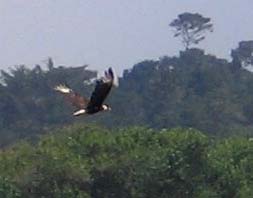 The
Crested
Caracara that appeared at Pt. Sur in March, and then Carmel River mouth
in April, is still frequenting the area. After appearances in Pacific Grove
& Pebble Beach in June, it reappeared at Carmel River mouth in July
(photo, right, 17 July © Stan Dryden). It also was seen in Pebble
Beach again in July, and may work a route between lower Carmel Valley and
the outer Monterey Peninsula. Meanwhile, elsewhere in California, there
were single Caracaras at Pt. Reyes and in Humboldt County. The
Crested
Caracara that appeared at Pt. Sur in March, and then Carmel River mouth
in April, is still frequenting the area. After appearances in Pacific Grove
& Pebble Beach in June, it reappeared at Carmel River mouth in July
(photo, right, 17 July © Stan Dryden). It also was seen in Pebble
Beach again in July, and may work a route between lower Carmel Valley and
the outer Monterey Peninsula. Meanwhile, elsewhere in California, there
were single Caracaras at Pt. Reyes and in Humboldt County. |
| In birds, as in life, "timing is everything." Bird occurrences are
remarkably predictable. Migrant and wintering birds in MTY appear each
year at the usual date, and depart at the predictable time, based on patterns
set by their ancestors for many eons before. Timing varies a little bit
— birds can be a week early or a week late, and sometimes a bit more, but
in 99.99% of the time, the timing of occurrences is pretty well set (see
pp. 47-48 of Monterey Birds, 2d ed., for a bit more on this topic).
One can say with some confidence, for example, that Monterey County will
not have a Blackpoll in February. We can also say with about that same
confidence that Monterey County will not have a Ferruginous Hawk in mid-summer.
Based on everything we know to date, the first migrant Ferruginous shouldn't
appear until the first week of September, and the last one to depart should
be no later than the first week of May. Maybe you could stretch that a
week or so, but it is fair to say that there is no reason to ever think
a Ferruginous Hawk would occur here in June or July. |
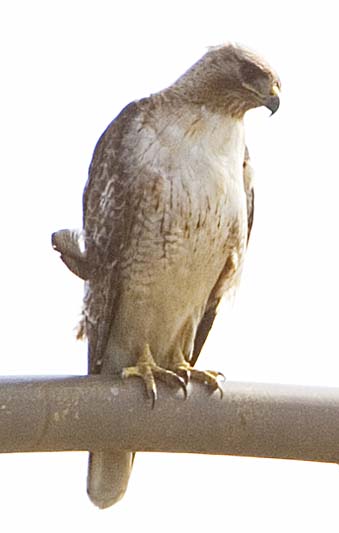 Thus
the recent spate of BirdBox reports of June or July reports of "Ferruginous
Hawk" warrants discussion. There have been such reports on at least 4 different
mid-summer days, involving probably the same 1 or 2 birds, between Seaside
and Yankee Pt. One of these was reported sitting on a light-pole
at Del Monte & Highway 1 on 19 July, and fortunately Bill Hill was
able to refind that bird within the hour (photos left and below;
© Bill Hill). You can see why it might be mistaken for a Ferruginous
on first glance: it has a (mostly) pale head and breast — unlike our usual
Red-tailed Hawks — and the tail looks rather all-whitish below from this
angle. But things change when it flies. As Bill Hill wrote: "It has a very
light colored head and mostly white breast but in flight the carpal bars
and red tail are sort of hard to ignore." In the shot below, you can see
the red tail and the black patagial bar that is diagnostic of Red-tailed
Hawk. This same bird remained at the same spot through today (21 July)
when again miscalled as a "Ferruginous." Thus
the recent spate of BirdBox reports of June or July reports of "Ferruginous
Hawk" warrants discussion. There have been such reports on at least 4 different
mid-summer days, involving probably the same 1 or 2 birds, between Seaside
and Yankee Pt. One of these was reported sitting on a light-pole
at Del Monte & Highway 1 on 19 July, and fortunately Bill Hill was
able to refind that bird within the hour (photos left and below;
© Bill Hill). You can see why it might be mistaken for a Ferruginous
on first glance: it has a (mostly) pale head and breast — unlike our usual
Red-tailed Hawks — and the tail looks rather all-whitish below from this
angle. But things change when it flies. As Bill Hill wrote: "It has a very
light colored head and mostly white breast but in flight the carpal bars
and red tail are sort of hard to ignore." In the shot below, you can see
the red tail and the black patagial bar that is diagnostic of Red-tailed
Hawk. This same bird remained at the same spot through today (21 July)
when again miscalled as a "Ferruginous."

On second look, there are lot of reasons, timing aside, that even the
perched bird was not a Ferruginous Hawk. For starters, the yellow legs
are bare, not feathered as on Ferruginous (and Rough-legged) Hawks. [In
fact, the old name of Ferruginous Hawk was "Ferruginous Rough-legged Hawk"
because of this feature.] The sides and flanks are barred, and there is
even a narrow breastband. On immature Ferruginous, there may be little
dots in these areas, but not bars. On adult Ferruginous, if the flanks
are barred at all, the thighs are much more heavily barred. Our mid-summer
hawk has white thighs. The hawk's proportions are also not right — not
big-headed enough — and it is just not a big enough hawk overall. In flight,
all ages of Ferruginous have white patagials on the underwing while the
upperwings show an extensive white patch at the base of the primaries (not
shown on the MTY bird). All Ferruginous of any age have all-white bases
to the undersides of the primaries, quite unlike the barred undersides
of the primaries on the MTY hawk.
Observers should keep in mind the wide variation possible in local Red-tailed
Hawks, of which this is just one example, and treat out-of-season reports
of hawks — or any species — with due skepticism.. There still are no MTY
records of Ferruginous Hawk in summer. If there ever were to be one, it
would need to be exceptionally well documented. [The same goes for other
equally unlikely hawks in coastal California in mid-summer, such as Rough-legged
Hawk.] Many thanks to Bill Hill for documenting this interesting raptor.
|
 In
early July, an adult Semipalmated Sandpiper was present at ponds
near Salinas for a few days (M. Brady, O. Johnson, B.L. Sullivan). You
can see nicely the webbing between the toes in this nice shot (left; ©
Oscar Johnson) Of course, Western Sandpiper also has webbing but this is
not a Western for a host of other reasons. Juvenal plumaged Semipalmated
Sandpipers are found annually in very small numbers but records of adults
are much scarcer, averaging less than one a year. In
early July, an adult Semipalmated Sandpiper was present at ponds
near Salinas for a few days (M. Brady, O. Johnson, B.L. Sullivan). You
can see nicely the webbing between the toes in this nice shot (left; ©
Oscar Johnson) Of course, Western Sandpiper also has webbing but this is
not a Western for a host of other reasons. Juvenal plumaged Semipalmated
Sandpipers are found annually in very small numbers but records of adults
are much scarcer, averaging less than one a year.
Alas, also in early July, the promising Caspian Tern, Black Skimmer,
and Heermann's Gull colony at the Salinas River mouth appeared to fail.
A goodly number of Caspian Tern adults had abandoned their nests, and there
were unhatched eggs lying around in the open. Only one Skimmer pair was
left, rather than three (see below for the June hopes), and no hatching
was reported. The single Heermann's Gull nest also apparently did not succeed.
The reason why the breeding season failed this summer is not readily apparent.
Could prey productivity been too poor in the ocean to support nestlings,
triggering a colony-wide collapse? |
| Great-tailed Grackles now nest at various reedy ponds throughout
MTY but they are still quite rare along the Big Sur coast. This female
(right) was foraging in Big Sur "town" itself on 25 June (Matt Brady, photo
© Oscar Johnson). |

|
|
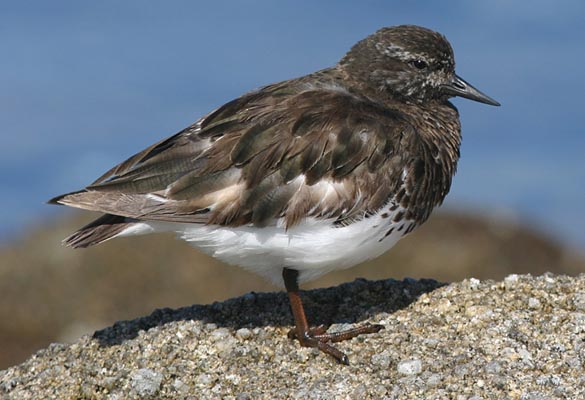 Mid
June is the one time of year when we have few local shorebirds. Spring
migration runs mostly late March to late May, with a trickle into June,
and then fall migration starts in late June with returning adults in breeding
plumage. It is essentially the two weeks between 10 June to ~25 June when
almost no migrants should be around. The only shorebirds (beyond the local
breeders like Killdeer) are over-summering individuals, presumably in their
first summer (exactly one year old). This Black Turnstone (left),
a nice shot © Brian L. Sullivan, is apparently an over-summering first-year
bird at Pt. Pinos on 21 June. Note that it has some new alternate-like
scapulars but is otherwise in a basic-like plumage; it does not have the
alternate (=breeding) plumage feathers on its head or breast. This is presumably
first-alternate
plumage for non-breeders [some, but not all, shorebirds do not attempt
to nest when only 1 year old]. Other species that routinely oversummer
here in small numbers are Black-bellied Plover, Marbled Godwit, Willet,
and Whimbrel. Virtually all of the small sandpipers apparently do migrate
to the Arctic and try to nest. But what to think of a breeding-plumaged
Dunlin at Big Sur River mouth on 17 June (Justyn Stahl)? Which way was
it going? Mid
June is the one time of year when we have few local shorebirds. Spring
migration runs mostly late March to late May, with a trickle into June,
and then fall migration starts in late June with returning adults in breeding
plumage. It is essentially the two weeks between 10 June to ~25 June when
almost no migrants should be around. The only shorebirds (beyond the local
breeders like Killdeer) are over-summering individuals, presumably in their
first summer (exactly one year old). This Black Turnstone (left),
a nice shot © Brian L. Sullivan, is apparently an over-summering first-year
bird at Pt. Pinos on 21 June. Note that it has some new alternate-like
scapulars but is otherwise in a basic-like plumage; it does not have the
alternate (=breeding) plumage feathers on its head or breast. This is presumably
first-alternate
plumage for non-breeders [some, but not all, shorebirds do not attempt
to nest when only 1 year old]. Other species that routinely oversummer
here in small numbers are Black-bellied Plover, Marbled Godwit, Willet,
and Whimbrel. Virtually all of the small sandpipers apparently do migrate
to the Arctic and try to nest. But what to think of a breeding-plumaged
Dunlin at Big Sur River mouth on 17 June (Justyn Stahl)? Which way was
it going?
By the last week of June, fall migration is
under way. Brian Sullivan had 24 Western Sandpipers at Zmudowski on 27
June — right on time for the first fall migrants. |
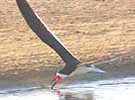 At
the Salinas River NWR, a pair of Black Skimmer were discovered in
mid-May on a nest in the large Caspian Tern colony there. One of the adults
is shown skimming on the freshwater pond on 11 May (photo right ©
Blake Matheson). By mid-June, three pairs were present (below ©
D. Roberson, 16 June 2006) and there were apparently 3 occupied nests (yellow
arrows; the middle nest is hidden in this view) guarded by 3 mates (red
arrows). Contrary to my guess, it is the males that do the bulk of the
brooding while the females provide the majority of the defense (Ehrlich
et al., 1988, The Birder's Handbook; I saw the right-hand mate vigorously
chase away a Heermann's Gull that got too close). There is one previous
nesting attempt here (in 2000) but that attempted failed (the eggs were
eaten by a predator). It would be fabulous if they fledged young this year
for the first MTY nesting success. At
the Salinas River NWR, a pair of Black Skimmer were discovered in
mid-May on a nest in the large Caspian Tern colony there. One of the adults
is shown skimming on the freshwater pond on 11 May (photo right ©
Blake Matheson). By mid-June, three pairs were present (below ©
D. Roberson, 16 June 2006) and there were apparently 3 occupied nests (yellow
arrows; the middle nest is hidden in this view) guarded by 3 mates (red
arrows). Contrary to my guess, it is the males that do the bulk of the
brooding while the females provide the majority of the defense (Ehrlich
et al., 1988, The Birder's Handbook; I saw the right-hand mate vigorously
chase away a Heermann's Gull that got too close). There is one previous
nesting attempt here (in 2000) but that attempted failed (the eggs were
eaten by a predator). It would be fabulous if they fledged young this year
for the first MTY nesting success. |

|
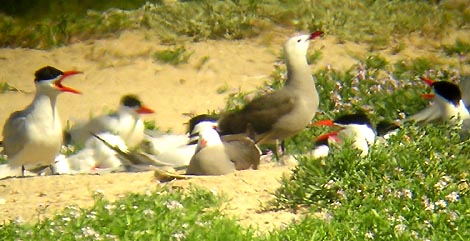 The
Caspian Tern colony had 309 nesting pairs last year, and may have about
that many this year. The protection that they give to other species — like
skimmers — permits less aggressive species to nest without predation by
Western Gulls. This year, for the first time, a pair of Heermann's Gull
was
on eggs in the tern colony by June (digiscope shot right © D. Roberson,
16 June) while a couple other pairs were courting. Perhaps this will offset
the failure of six nests of Heermann's Gull on the islets in Roberts Lake,
Seaside, this year? The
Caspian Tern colony had 309 nesting pairs last year, and may have about
that many this year. The protection that they give to other species — like
skimmers — permits less aggressive species to nest without predation by
Western Gulls. This year, for the first time, a pair of Heermann's Gull
was
on eggs in the tern colony by June (digiscope shot right © D. Roberson,
16 June) while a couple other pairs were courting. Perhaps this will offset
the failure of six nests of Heermann's Gull on the islets in Roberts Lake,
Seaside, this year?
The colony of Caspian Terns at the Salinas River mouth is a wonderful
new phenomena. There were attempts to breed here in 1983, 1986, and 2000
— all unsuccessful. Only one nest fledged young in 2001, but numbers of
nesting pairs have steadily increased ever since: 93 (2002), 167 (2003),
228 (2004) and 309 (2005; all USF&G statistics). At least 340 adults
were present on 16 June but this was surely an undercount, as many nesting
spots cannot be seen from the public trail. The colony is, of course, off
limits to all during the nesting season, as disturbance can destroy nests. |
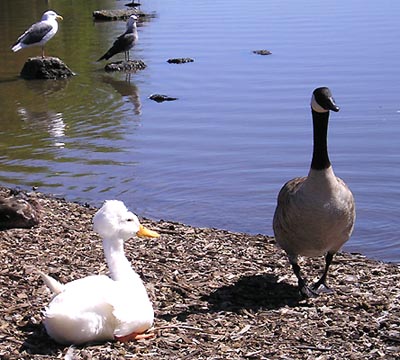 |
Speaking of Roberts Lake, Brian Weed conducted a survey of adult Canada
Geese there in June, as well as counting the geese on Laguna Grande
and El Estero lakes. He found 725 adults between the three lakes. This
is an 148% increase from a similar survey done in June 2001. So our local
non-native goose population has been increasing at the pace of 30% a year
over the past 5 years.
One of those honkers appears in the foreground (left), and a failed
Heermann's nester hangs about in the background, but I'm unsure of the
i.d. of the other waterfowl in the shot. Can Tasker's Sulphureous Duck
be eliminated? [Best response to this question will win a prize... include
your snail mail address for that purpose.] |
|
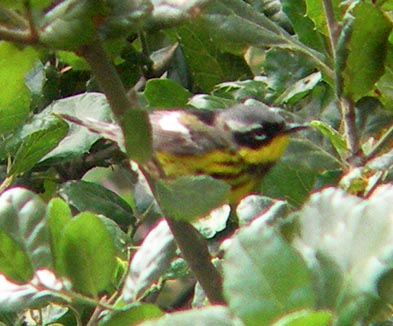 Birds
of note at the Big Sur River mouth in June included up to 5 singing male
Northern Parula (will they nest again?), several Rose-breasted Grosbeak,
and a singing male Magnolia Warbler on 10 June (photo right ©
Oscar Johnson). This is only the 3rd spring record for MTY, the first one
found alive in June, and the first to be documented by a photo in spring. Birds
of note at the Big Sur River mouth in June included up to 5 singing male
Northern Parula (will they nest again?), several Rose-breasted Grosbeak,
and a singing male Magnolia Warbler on 10 June (photo right ©
Oscar Johnson). This is only the 3rd spring record for MTY, the first one
found alive in June, and the first to be documented by a photo in spring.
An interesting caprimulgid puzzled observers on the sandbar at Big Sur
R. mouth on 9 June. Initially found and flushed during the day, the bird
did not show white or buffy bars across the primaries as would be expected
for nighthawks and, at dusk, although it flew like a nighthawk, a dozen
observers scrutinizing it in flight still did not see the primary bar that
is so characteristic of nighthawks. Yet Ryan Terrill's fine photo (below
© Ryan Terrill) is undoubtedly that of a Lesser Nighthawk,
likely a first-summer ("SY" in banding terminology) female. Birds in this
plumage have retained juvenal remiges (Pyle, 1997, ID Guide of North
American Birds), which may account for the apparent lack of a primary
bar. Note the very small bill, the lack of rictal bristles, and the buffy
spots along the outer edge of the outer primaries; the first two characters
eliminate all caprimulgids except nighthawk, and the buff spots are typical
of Lesser Nighthawk. Oddities, though, including the spotted throat and
breast, rather than the expected white throat. |
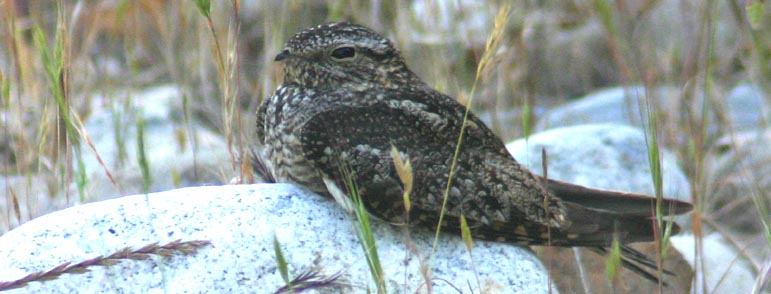
|
|
|
|
 The
Crested
Caracara that appeared at Pt. Sur in March, and then Carmel River mouth
in April, is still frequenting the area. After appearances in Pacific Grove
& Pebble Beach in June, it reappeared at Carmel River mouth in July
(photo, right, 17 July © Stan Dryden). It also was seen in Pebble
Beach again in July, and may work a route between lower Carmel Valley and
the outer Monterey Peninsula. Meanwhile, elsewhere in California, there
were single Caracaras at Pt. Reyes and in Humboldt County.
The
Crested
Caracara that appeared at Pt. Sur in March, and then Carmel River mouth
in April, is still frequenting the area. After appearances in Pacific Grove
& Pebble Beach in June, it reappeared at Carmel River mouth in July
(photo, right, 17 July © Stan Dryden). It also was seen in Pebble
Beach again in July, and may work a route between lower Carmel Valley and
the outer Monterey Peninsula. Meanwhile, elsewhere in California, there
were single Caracaras at Pt. Reyes and in Humboldt County. Thus
the recent spate of BirdBox reports of June or July reports of "Ferruginous
Hawk" warrants discussion. There have been such reports on at least 4 different
mid-summer days, involving probably the same 1 or 2 birds, between Seaside
and Yankee Pt. One of these was reported sitting on a light-pole
at Del Monte & Highway 1 on 19 July, and fortunately Bill Hill was
able to refind that bird within the hour (photos left and below;
© Bill Hill). You can see why it might be mistaken for a Ferruginous
on first glance: it has a (mostly) pale head and breast — unlike our usual
Red-tailed Hawks — and the tail looks rather all-whitish below from this
angle. But things change when it flies. As Bill Hill wrote: "It has a very
light colored head and mostly white breast but in flight the carpal bars
and red tail are sort of hard to ignore." In the shot below, you can see
the red tail and the black patagial bar that is diagnostic of Red-tailed
Hawk. This same bird remained at the same spot through today (21 July)
when again miscalled as a "Ferruginous."
Thus
the recent spate of BirdBox reports of June or July reports of "Ferruginous
Hawk" warrants discussion. There have been such reports on at least 4 different
mid-summer days, involving probably the same 1 or 2 birds, between Seaside
and Yankee Pt. One of these was reported sitting on a light-pole
at Del Monte & Highway 1 on 19 July, and fortunately Bill Hill was
able to refind that bird within the hour (photos left and below;
© Bill Hill). You can see why it might be mistaken for a Ferruginous
on first glance: it has a (mostly) pale head and breast — unlike our usual
Red-tailed Hawks — and the tail looks rather all-whitish below from this
angle. But things change when it flies. As Bill Hill wrote: "It has a very
light colored head and mostly white breast but in flight the carpal bars
and red tail are sort of hard to ignore." In the shot below, you can see
the red tail and the black patagial bar that is diagnostic of Red-tailed
Hawk. This same bird remained at the same spot through today (21 July)
when again miscalled as a "Ferruginous."

 Mid
June is the one time of year when we have few local shorebirds. Spring
migration runs mostly late March to late May, with a trickle into June,
and then fall migration starts in late June with returning adults in breeding
plumage. It is essentially the two weeks between 10 June to ~25 June when
almost no migrants should be around. The only shorebirds (beyond the local
breeders like Killdeer) are over-summering individuals, presumably in their
first summer (exactly one year old). This Black Turnstone (left),
a nice shot © Brian L. Sullivan, is apparently an over-summering first-year
bird at Pt. Pinos on 21 June. Note that it has some new alternate-like
scapulars but is otherwise in a basic-like plumage; it does not have the
alternate (=breeding) plumage feathers on its head or breast. This is presumably
first-alternate
plumage for non-breeders [some, but not all, shorebirds do not attempt
to nest when only 1 year old]. Other species that routinely oversummer
here in small numbers are Black-bellied Plover, Marbled Godwit, Willet,
and Whimbrel. Virtually all of the small sandpipers apparently do migrate
to the Arctic and try to nest. But what to think of a breeding-plumaged
Dunlin at Big Sur River mouth on 17 June (Justyn Stahl)? Which way was
it going?
Mid
June is the one time of year when we have few local shorebirds. Spring
migration runs mostly late March to late May, with a trickle into June,
and then fall migration starts in late June with returning adults in breeding
plumage. It is essentially the two weeks between 10 June to ~25 June when
almost no migrants should be around. The only shorebirds (beyond the local
breeders like Killdeer) are over-summering individuals, presumably in their
first summer (exactly one year old). This Black Turnstone (left),
a nice shot © Brian L. Sullivan, is apparently an over-summering first-year
bird at Pt. Pinos on 21 June. Note that it has some new alternate-like
scapulars but is otherwise in a basic-like plumage; it does not have the
alternate (=breeding) plumage feathers on its head or breast. This is presumably
first-alternate
plumage for non-breeders [some, but not all, shorebirds do not attempt
to nest when only 1 year old]. Other species that routinely oversummer
here in small numbers are Black-bellied Plover, Marbled Godwit, Willet,
and Whimbrel. Virtually all of the small sandpipers apparently do migrate
to the Arctic and try to nest. But what to think of a breeding-plumaged
Dunlin at Big Sur River mouth on 17 June (Justyn Stahl)? Which way was
it going?
 At
the Salinas River NWR, a pair of Black Skimmer were discovered in
mid-May on a nest in the large Caspian Tern colony there. One of the adults
is shown skimming on the freshwater pond on 11 May (photo right ©
Blake Matheson). By mid-June, three pairs were present (below ©
D. Roberson, 16 June 2006) and there were apparently 3 occupied nests (yellow
arrows; the middle nest is hidden in this view) guarded by 3 mates (red
arrows). Contrary to my guess, it is the males that do the bulk of the
brooding while the females provide the majority of the defense (Ehrlich
et al., 1988, The Birder's Handbook; I saw the right-hand mate vigorously
chase away a Heermann's Gull that got too close). There is one previous
nesting attempt here (in 2000) but that attempted failed (the eggs were
eaten by a predator). It would be fabulous if they fledged young this year
for the first MTY nesting success.
At
the Salinas River NWR, a pair of Black Skimmer were discovered in
mid-May on a nest in the large Caspian Tern colony there. One of the adults
is shown skimming on the freshwater pond on 11 May (photo right ©
Blake Matheson). By mid-June, three pairs were present (below ©
D. Roberson, 16 June 2006) and there were apparently 3 occupied nests (yellow
arrows; the middle nest is hidden in this view) guarded by 3 mates (red
arrows). Contrary to my guess, it is the males that do the bulk of the
brooding while the females provide the majority of the defense (Ehrlich
et al., 1988, The Birder's Handbook; I saw the right-hand mate vigorously
chase away a Heermann's Gull that got too close). There is one previous
nesting attempt here (in 2000) but that attempted failed (the eggs were
eaten by a predator). It would be fabulous if they fledged young this year
for the first MTY nesting success.